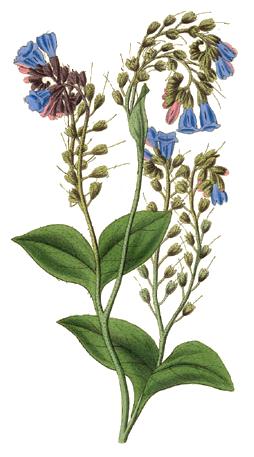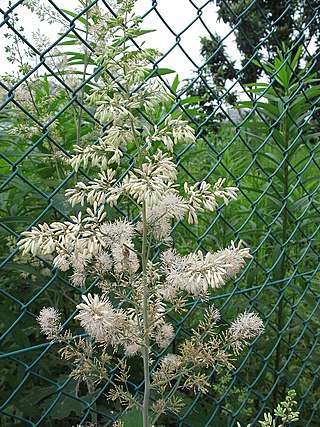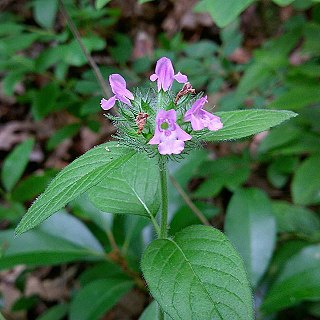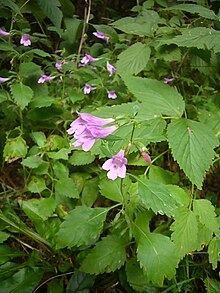
Satureja is a genus of aromatic plants of the family Lamiaceae, related to rosemary and thyme. It is native to North Africa, southern and southeastern Europe, the Middle East, and Central Asia. A few New World species were formerly included in Satureja, but they have all been moved to other genera. Several species are cultivated as culinary herbs called savory, and they have become established in the wild in a few places.

Geranium is a genus of 422 species of annual, biennial, and perennial plants that are commonly known as geraniums or cranesbills. They are found throughout the temperate regions of the world and the mountains of the tropics, with the greatest diversity in the eastern part of the Mediterranean region.

Symphytum is a genus of flowering plants in the borage family, Boraginaceae, known by the common name comfrey. There are 59 recognized species. Some species and hybrids, particularly S. officinale, Symphytum grandiflorum, and S. × uplandicum, are used in gardening and herbal medicine. They are not to be confused with Andersonglossum virginianum, known as wild comfrey, another member of the borage family.

Clinopodium is a genus of flowering plants in the family Lamiaceae. It is in the tribe Mentheae of the subfamily Nepetoideae, but little else can be said with certainty about its phylogenetic position.

Macleaya cordata, the five-seeded plume-poppy, is a species of flowering plant in the poppy family Papaveraceae, which is used ornamentally. It is native to China and Japan. It is a large herbaceous perennial growing to 2.5 m (8 ft) tall by 1 m (3 ft) or more wide, with olive green leaves and airy panicles of buff-white flowers in summer.

Geum quellyon, commonly called scarlet avens, Chilean avens, Double Bloody Mary, or Grecian rose, is a perennial herb in the family Rosaceae. It is native to the central and southern regions of Chile. G. quellyon has been introduced to other countries including Belgium, Bolivia, and the United Kingdom, where it was first planted in 1826.

Origanum syriacum; syn. Majorana syriaca, bible hyssop, Biblical-hyssop, Lebanese oregano or Syrian oregano, is an aromatic perennial herb in the mint family, Lamiaceae.

Coreopsis verticillata is a North American species of tickseed in the sunflower family. It is found primarily in the east-central United States, from Maryland south to Georgia, with isolated populations as far west as Oklahoma and as far north as Québec and Ontario. The common names are whorled tickseed, whorled coreopsis, thread-leaved tickseed, thread leaf coreopsis, and pot-of-gold.

Epimedium grandiflorum, the large flowered barrenwort, or bishop's hat, is a species of flowering plant in the family Berberidaceae, native to Japan and Korea.

Phlox paniculata is a species of flowering plant in the phlox family (Polemoniaceae). It is native to parts of the eastern and central United States. It is extensively cultivated in temperate regions as an ornamental plant and has become established in the wild in scattered locales in other regions. Common names include fall phlox, garden phlox, perennial phlox, summer phlox, and panicled phlox.

Clinopodium nepeta, known as lesser calamint, is a perennial herb of the mint family.
Clinopodium mimuloides is a species of flowering plant in the mint family known by the common name monkeyflower savory. It is endemic to California.

Digitalis × fulva, the strawberry foxglove, is a hybrid species of flowering plant within the family Plantaginaceae. It is a naturally occurring fertile hybrid between the species Digitalis grandiflora and Digitalis purpurea. The species is widely marketed in the UK under the common name strawberry foxglove or its taxonomic synonym Digitalis × mertonensis. The species has been used to produce various cultivars and has gained the Royal Horticultural Society's Award of Garden Merit.

Stephensia brunnichella is a moth of the family Elachistidae found in Europe and east into the Palearctic.

Clinopodium dentatum is a species of flowering plant in the mint family known by the common names toothed savory and Florida calamint. It is native to Florida and Georgia in the United States.

Clinopodium glabellum is a species of flowering plant in the mint family. It is commonly known as glade calamint, glade savory, and glade wild basil. It is native to the Nashville Basin of Tennessee, the Bluegrass Region of Kentucky, and two counties in Alabama. Within this range, it is found only on wet cedar glades and in seeps along limestone creekbeds. Due to its narrow range and specific habitat requirements, this species is considered vulnerable.

Clinopodium vulgare, the wild basil, is a species of flowering plant in the family Lamiaceae.

Clinopodium menthifolium, commonly known as the wood calamint or woodland calamint, is a species of flowering plant in the mint family, Lamiaceae. It is found throughout southern and central Europe from the United Kingdom and east as far as temperate parts of Asia, and as south as North Africa. It grows up to 1,700 m (5,600 ft) in elevation.

Clinopodium coccineum, commonly known as scarlet calamint or red basil, is a evergreen perennial plant of the family Lamiaceae.


















